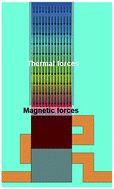Our official English website, www.x-mol.net, welcomes your
feedback! (Note: you will need to create a separate account there.)
Enrichment of magnetic particles using temperature and magnetic field gradients induced by benchtop fabricated micro-electromagnets
Lab on a Chip ( IF 6.1 ) Pub Date : 2017-10-17 00:00:00 , DOI: 10.1039/c7lc00825b A. Hosseini 1, 2, 3, 4 , D. N. Philpott 2, 3, 4, 5 , L. Soleymani 1, 2, 3, 4, 5
Lab on a Chip ( IF 6.1 ) Pub Date : 2017-10-17 00:00:00 , DOI: 10.1039/c7lc00825b A. Hosseini 1, 2, 3, 4 , D. N. Philpott 2, 3, 4, 5 , L. Soleymani 1, 2, 3, 4, 5
Affiliation

|
The active transport of analytes inside biosensing systems is important for reducing the response time and enhancing the limit-of-detection of these systems. Due to the ease of functionalization with bio-recognition agents and manipulation with magnetic fields, magnetic particles are widely used for active and directed transport of biological analytes. On-chip active electromagnets are ideally suited for manipulating magnetic particles in an automated and miniaturized fashion inside biosensing systems. Unfortunately, the magnetic force exerted by these devices decays rapidly as we move away from the device edges, and increasing the generated force to the levels necessary for particle manipulation requires a parallel increase in the applied current and the resultant Joule heating. In this paper, we designed a study to understand the combined role of thermal and magnetic forces on the movement of magnetic particles in order to extend the interaction distance of on-chip magnetic devices beyond the device edges. For this purpose, we used a rapid prototyping method to create an active/passive on-chip electromagnet with a micro/nano-structured active layer and a patterned ferromagnetic passive layer. We demonstrated that the measured terminal velocities of particles positioned near the electromagnet edge (∼5.5 μm) closely reflect the values obtained by multi-physics modelling. Interestingly, we observed a two orders of magnitude deviation between the experimental and modelling results for the terminal velocities of particles far from the electromagnet edge (∼55.5 μm). Heat modelling of the system using experimentally-measured thermal gradients indicates that this discrepancy is related to the enhanced fluid movement caused by thermal forces. This study enables the rational design of thermo-magnetic systems for thermally driving and magnetically capturing particles that are positioned at distances tens to hundreds of microns away from the edges of on-chip magnetic devices.
中文翻译:

利用台式微电磁铁诱导的温度和磁场梯度富集磁性粒子
生物传感系统内部分析物的主动运输对于减少响应时间和增强这些系统的检测限非常重要。由于易于使用生物识别剂进行功能化以及通过磁场进行操作,磁性颗粒被广泛用于生物分析物的主动和定向运输。片上有源电磁体非常适合在生物传感系统内部以自动化和小型化的方式处理磁性粒子。不幸的是,当我们从设备边缘移开时,这些设备施加的磁力会迅速衰减,并且将所产生的力增加到粒子操纵所需的水平时,需要同时增加施加的电流和由此产生的焦耳热。在本文中,我们设计了一项研究,以了解热力和磁力对磁性粒子运动的综合作用,从而将片上磁性设备的相互作用距离扩展到设备边缘之外。为此,我们使用了快速原型制作方法来创建具有微/纳米结构有源层和图案化铁磁无源层的有源/无源芯片上电磁铁。我们证明,位于电磁体边缘(〜5.5μm)附近的颗粒的测得的终端速度紧密反映了通过多物理场建模获得的值。有趣的是,对于远离电磁体边缘(〜55.5μm)的粒子的最终速度,我们在实验结果和建模结果之间观察到两个数量级的偏差。使用实验测得的热梯度对系统进行热建模表明,这种差异与热力引起的流体运动增强有关。这项研究可以合理设计热磁系统,以热驱动和磁捕获距离片上磁性设备边缘数十到数百微米的粒子。
更新日期:2017-10-27
中文翻译:

利用台式微电磁铁诱导的温度和磁场梯度富集磁性粒子
生物传感系统内部分析物的主动运输对于减少响应时间和增强这些系统的检测限非常重要。由于易于使用生物识别剂进行功能化以及通过磁场进行操作,磁性颗粒被广泛用于生物分析物的主动和定向运输。片上有源电磁体非常适合在生物传感系统内部以自动化和小型化的方式处理磁性粒子。不幸的是,当我们从设备边缘移开时,这些设备施加的磁力会迅速衰减,并且将所产生的力增加到粒子操纵所需的水平时,需要同时增加施加的电流和由此产生的焦耳热。在本文中,我们设计了一项研究,以了解热力和磁力对磁性粒子运动的综合作用,从而将片上磁性设备的相互作用距离扩展到设备边缘之外。为此,我们使用了快速原型制作方法来创建具有微/纳米结构有源层和图案化铁磁无源层的有源/无源芯片上电磁铁。我们证明,位于电磁体边缘(〜5.5μm)附近的颗粒的测得的终端速度紧密反映了通过多物理场建模获得的值。有趣的是,对于远离电磁体边缘(〜55.5μm)的粒子的最终速度,我们在实验结果和建模结果之间观察到两个数量级的偏差。使用实验测得的热梯度对系统进行热建模表明,这种差异与热力引起的流体运动增强有关。这项研究可以合理设计热磁系统,以热驱动和磁捕获距离片上磁性设备边缘数十到数百微米的粒子。











































 京公网安备 11010802027423号
京公网安备 11010802027423号